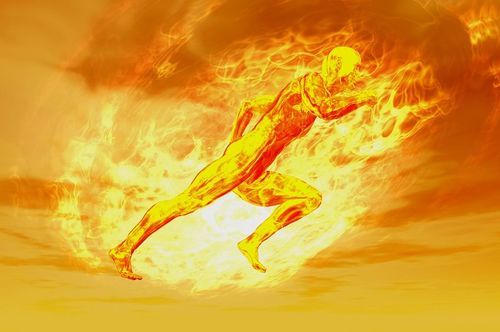Running in the Heat
Running in the heat is much harder than running in cooler temperatures. Without preparation the heat can be punishing or even dangerous. The most important step is to realize that running in the heat requires just as much care as running in extreme cold.
Contents
[hide]1 Heat can kill
Running in the heat can kill, as the bodies protective mechanisms that normally cause us to slow down can be ineffective. There are a number of risk factors for serious heat injury
- Being overweight, as fat can act as an insulator.
- Being untrained, as fitness gives some heat adaptation over the unfit, and also teaches the mind some of the danger signs of heat problems.
- Lack of heat acclimatization, which both gives protection from the heat and also teaches the mind to adjust the intensity based on heat.
- Thinking you can run faster than you can in the conditions.
- Having suffered from heat illness before
- Ignoring warning signs (see below)
2 Staying Alive in the Heat - The Warning Signs
The best advice seems to be to take things cautiously if you are not used to running in the heat. Pushing yourself harder than normal in familiar heat, or attempting to run normally in heat you are not used to is dangerous. Traveling to a warmer area for a race is especially risky. Look out for the following warning signs, and if you have any doubts, slow down or stop and cool off.
- Nausea or vomiting. These symptoms can occur before true heatstroke, as running makes digestion harder.
- Weakness. An unusual muscular weakness could be due to low blood sugar, but elevated core temperature also creates weakness.
- Headache. This can also be caused by dehydration, or low blood sugar. Having had headaches from each of the three causes, I have found the type of headache is different. My limited experience is that a headache cased by heat is particularly painful and intense.
- Dizziness or confusion. This is a serious symptom that suggests either extremely low blood sugar or heatstroke.
- Flushed/Hot Skin. I've found that an early warning sign is the feeling that my skin is burning, especially my face.
- Panting. Another symptom I've found of overheating is that my breathing becomes labored beyond what is reasonable for the exercise intensity.
- Core Temperature. The only sure test is to check your core temperature using something like an in-ear thermometer. Using a mouth thermometer may not be accurate if you've been breathing hard.
If you have any doubts, stop and check your temperature. Avoid high intensity interval training in the heat; the intense work can spike your core temperature too high too quickly for you to recover. It's possible that a runner that suffers heat stroke may exhibit none, or only one of these warning signs.
3 Tips for Running in the Heat
- Get used to running in the heat slowly. See Heat Acclimation Training for more details
- Check the temperature and humidity before you run. Knowing what to expect can help you adjust your pace. Remember that humidity has a big impact on your ability to cool off.
- Run in the cooler parts of the day. Early morning and later in the evening work well, late afternoon is often the worst.
- Stay Hydrated. The entry on Practical Hydration covers hydration and electrolytes. Remember that electrolytes are as important as water for staying hydrated. Hyponatremia can kill!
- Cold drinks can also help lower your body temperature, but don't drink too much without electrolytes (see above tip on hydration)
- Wear white. It may not be your favorite color, but it is the coolest.
- Under Armor Heat Gear Top in white can keep you cooler than bare skin
- Wear a (white) hat. In very hot, sunny conditions, a 'legionaries cap' can help protect your neck and face.
- Adjust your pace for the heat. See Impact of Heat on Marathon Performance for some guidelines.
- Protect yourself from the UV. Either wear sunscreen, or cover up. Remember that skin cancer is a nasty way to die.
- Wear sunglasses with UV protection. I love my Oakley Half Jackets ;}
- Wearing a 'cool off bandanna' filled with ice works wonders. http://www.zombierunner.com/store/product152.html
- Pouring water over yourself can help slightly
- Watch out for blisters as your feet are more likely to be wet than in cooler conditions.
- Run in the shade of possible.
- Plan ahead; carry more drink with you than you expect to need.
- For speed work, prefer shorter intervals and be very cautious.
- Take walking breaks to cool off if you are having problems
- Watch out for the warning signs listed above. I find nausea is the first sign I have of overheating and headache is my first sign of dehydration.
- Carry a cell phone. If you get it wrong, you can call for help. (This is true in many situations.)
- Changing your running route so that you are doing several shorter loops or out-and-backs. You can then cache some drinks for each section rather than carrying enough for the whole run.
- Ice bandanas can also be used around the wrists. (Jim P)
- Ice under the hat. (Jim P)
- If you are doing loops, keep a spare shirt in a cooler full of ice, and switch every loop. (Jim P)
- Even holding some ice in your hand, or holding a cold water bottle can help.
- Some antidepressant medications have been linked to heatstroke.
